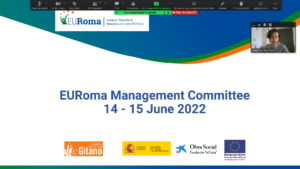 EURoma Network organised its online Management Committee meeting on 14-15 June. The meeting gathered representatives of Network partner organisations (public bodies responsible for European Cohesion Policy Funds -mainly ESF/ESF+ and ERDF- and those in charge of Roma policies, notably National Roma Contact Points) from 14 EU Member States and representatives of the Network Technical Secretariat (Fundación Secretariado Gitano).
EURoma Network organised its online Management Committee meeting on 14-15 June. The meeting gathered representatives of Network partner organisations (public bodies responsible for European Cohesion Policy Funds -mainly ESF/ESF+ and ERDF- and those in charge of Roma policies, notably National Roma Contact Points) from 14 EU Member States and representatives of the Network Technical Secretariat (Fundación Secretariado Gitano).
It also counted on the involvement and input of a large number of representative from the European Commission’s Directorate-Generals (DGs) with competences in Roma inclusion, ESF/ESF+ and ERDF as well as other areas addressed at the meeting (including DG Justice and Consumers (DG JUST), DG Employment, Social Affairs and Inclusion (DG EMPL), DG Regional and Urban Policy (DG REGIO), DG Migration and Home Affairs (DG HOME) and DG Education, Youth, Sports and Culture (DG EAC). Representatives of the European Union Agency for Fundamental Rights (FRA) also joined the meeting to share the Agency’s work and experience on some of the topics addressed.
In line with EURoma’s objective to promote an increased and more effective use of European Cohesion Policy Funds for the promotion of social inclusion, equal opportunities and the fight against discrimination of the Roma population, the meeting’s agenda included a large number of topics related to the situation of Roma as well as to the policy and financial instruments available to address it, with particular attention to the connection between them.
Roma Strategic Frameworks and European Cohesion Policy Funds
Given the crucial role that European Cohesion Policy Funds (both ESF/ESF+ and ERDF) can play in the implementation of the National/Regional Roma Strategic Frameworks (NRSFs)/set of measures, this session aimed to review the state-of-play of the submission of National Roma Strategic Frameworks/sets of measures by the different EU Member States as well as whether (and how) they are considering European Cohesion Policy Funds.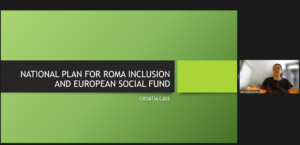
Following the information shared by European Commission, EURoma partners had the opportunity to exchange on the situation in their respective countries and notably on the progress made in relation to the previous National Roma Strategies and/or the 2014-2020 programming period. To contribute to this exchange, experiences from two partner countries (Croatia and Spain) where there has been a clear progress in guaranteeing the funding of NRSFs through European Cohesion Policy Funds, among other funding sources, where shared.
Ukraine war and Roma
Particular attention was paid to Roma fleeing the conflict in Ukraine in order to better understand their specific situation and needs (including the challenges it seems they are facing) and how to take full advantage of the EU instruments available to address them.
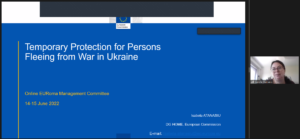 Following the presentation by the European Union Agency for Fundamental Rights (FRA) on their initial observations as regards the situation of Roma and the responses that are given by different stakeholders, European Commission representatives presented the EU instruments at the disposal of EU Member States. On the one hand, the Temporary Protection Directive and the protection it can confer to Roma people entering the EU, including the criteria and potential challenges to have access to its protection. On the other hand, the financial instruments that have been put in place (notably the REACT-EU and the CARE) that allow using funds such as ESF+ and ERDF to take action.
Following the presentation by the European Union Agency for Fundamental Rights (FRA) on their initial observations as regards the situation of Roma and the responses that are given by different stakeholders, European Commission representatives presented the EU instruments at the disposal of EU Member States. On the one hand, the Temporary Protection Directive and the protection it can confer to Roma people entering the EU, including the criteria and potential challenges to have access to its protection. On the other hand, the financial instruments that have been put in place (notably the REACT-EU and the CARE) that allow using funds such as ESF+ and ERDF to take action.
EU Anti-Racism Action Plan and Roma equality and inclusion
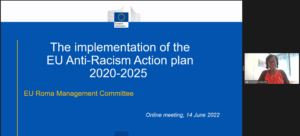 The state-of-play of the elaboration and submission of the EU Anti-Racism National Action Plans was another topic addressed at the meeting. Particular attention was paid to exploring the options available to promote the alignment and synergies between these action plans and the Roma Strategic Frameworks (at national and regional levels) in partners countries.
The state-of-play of the elaboration and submission of the EU Anti-Racism National Action Plans was another topic addressed at the meeting. Particular attention was paid to exploring the options available to promote the alignment and synergies between these action plans and the Roma Strategic Frameworks (at national and regional levels) in partners countries.
European Child Guarantee and Roma children
The potential of the Child Guarantee to promote equality and inclusion among Roma boys and girls was on the key topics addressed at the meeting given the potential of this instrument, which explicitly mentions Roma children as one of the groups facing particular disadvantages and, therefore, requiring special attention.
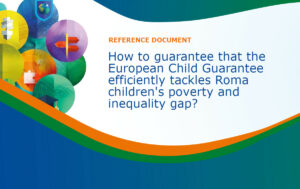 The Reference Document “How to guarantee that the European Child Guarantee efficiently tackles Roma children’s poverty and inequality gap?” elaborated within the EURoma Network served as reference in the discussions. The document aims to identify critical aspects to consider in the context of the Child Guarantee National Action Plans (both in the elaboration and the implementation phases) and of the 2021-2027 programming period of the European Cohesion Policy Funds 2021-2027 (notably ESF+ and ERDF) in order to guarantee that they contribute to efficiently tackle the poverty and inequality gap currently faced by Roma children.
The Reference Document “How to guarantee that the European Child Guarantee efficiently tackles Roma children’s poverty and inequality gap?” elaborated within the EURoma Network served as reference in the discussions. The document aims to identify critical aspects to consider in the context of the Child Guarantee National Action Plans (both in the elaboration and the implementation phases) and of the 2021-2027 programming period of the European Cohesion Policy Funds 2021-2027 (notably ESF+ and ERDF) in order to guarantee that they contribute to efficiently tackle the poverty and inequality gap currently faced by Roma children.
Building upon the presentations delivered by European Commission representatives, participants reviewed how Roma equality and inclusion is considered in the Child Guarantee National Action Plans and the options to programme Roma-related actions within the Child Guarantee in national/regional ESF+ and ERDF programmes in the 2021-2027 programming period.
European Cohesion Policy Funds indicator and monitoring framework and Roma equality and inclusion
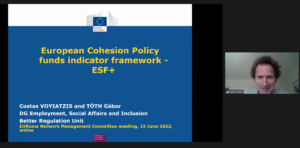 Despite progress made over the programming periods, the establishment of indicators and a monitoring framework that allow measuring the impact of interventions (whether target or mainstream) on Roma is one of the areas that still raises more challenges and concerns. In this context, building upon the presentations by European Commission and FRA representatives, the session allowed participants to review the European Cohesion Policy Funds indicator and monitoring framework and how this applies to actions related to Roma inclusion and equality and to address some of the most challenging areas and options to address them (e.g. specific indicators, data gathering…).
Despite progress made over the programming periods, the establishment of indicators and a monitoring framework that allow measuring the impact of interventions (whether target or mainstream) on Roma is one of the areas that still raises more challenges and concerns. In this context, building upon the presentations by European Commission and FRA representatives, the session allowed participants to review the European Cohesion Policy Funds indicator and monitoring framework and how this applies to actions related to Roma inclusion and equality and to address some of the most challenging areas and options to address them (e.g. specific indicators, data gathering…).
Other relevant aspects related to programming and Roma equality and inclusion
Other relevant aspects related to programming and Roma equality and inclusion were also addressed, notably:
- Social inclusion and innovation in the 2021-2027 programming period
- The opportunities offered by the ALMA (Aim, Learn, Master, Achieve) initiative for Roma youngsters.
EURoma Network activities
To conclude EURoma partners reviewed ongoing and upcoming EURoma activities in line with its three lines of action: mutual learning and transfer of knowledge and experience, generation of knowledge based on experices, and presence in European fora and initiatives.

